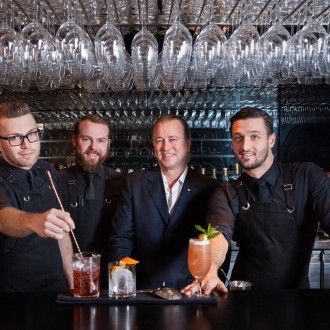High-altitude dining — with attitude

The first ‘in flight’ food was served on a Handley Page flight from London to Paris in 1919 and the airline catering industry hasn’t looked back since.
Nowadays the scale of airline meals is staggering, for example Emirates Flight Catering facility (EKFC) in Dubai prepares up to 180,000 meals each day. In 2014 the EKFC supplied almost 50 million meals for Emirates flights and 8.236 million for other airlines. And this represents only 65% of the meals prepared by Emirates!
The $159 million Dubai facility covers 88,000 m2 and features a 2.55 km-long electric monorail, which transports meal carts to and from the planes. Initially, the facility was designed with a capacity of 150,000 meals per day in mind, although after various expansion efforts, it is now capable of producing over 175,000 meals a day and operates 24 hours/day. On any given day, 119,000 economy meals, 19,000 business-class meals, 2500 first-class meals and11,000 crew meals will be served onboard Emirates 249 aircraft.
With such large-scale catering, food safety is a major concern. Urban myth has it that the two pilots on a flight are served different meals — and cannot share — just to avoid both being struck down with food poisoning.
Emirates Flight Catering Senior Vice President Joost Heymeijer puts food safety at the top of his agenda: insisting that the key to keeping things above board and pure is to have complete ‘traceability’.
The scale of the airline catering kitchens is immense.
At the United Airlines catering facility, Chelsea Food Services, located near Newark International Airport in New Jersey, a team of 1000 produces 33,000 meals per day.
There is little automation with vegetables being hand chopped. Food is only part cooked. Steak, for example, is cooked 30% of the way with the final cook being done onboard in the aircraft’s convection ovens. Meals are not allowed to sit for more than six to eight hours before boarding a plane. If a flight is delayed for more than a couple of hours, all of its meals could get thrown out and replaced. Not only is the food wasted, but employees have to work overtime to get the new food ready.
At Emirates, 500 chefs cook the huge array of fresh food before it’s frozen in super-fast blast freezers: 58 million bread rolls; 15 million croissants; 13 million eggs; 4300 tons of chicken; 1100 tons of lamb; 3.6 tons of lobster.
Safety regulations prohibit the use of open-flame grills in commercial aircraft, meaning cabin crew warm the pre-cooked frozen meals.
The rumour that airline food is designed to make you relax and even fall asleep is laughed at by airline caterers — though the chefs do choose meals that are more flavoursome to overcome the slight taste alterations experienced when dining at altitude.
Airline cuisine has been going through a bit of a renaissance as airlines compete for passengers. Air France upped the ante with its a la carte options in 2014, offering cocktails, gourmet selections and ice-cream on elegant trays designed by Eugeni Quitllet, a student of legendary French designer Philippe Starck.
In the US, Delta Air Lines has furthered its partnership with Danny Meyer’s Union Square Hospitality Group (on the coattails of its alliance with Blue Smoke restaurant in 2013) with an exclusive menu.
Catering to the palates of business- and first-class passengers means many airlines are now partnering with Michelin-starred chefs.
- Hawaiian Airlines Featured Chef series — the airline is featuring locally inspired meals from five of the islands’ top chefs on a six-month rotation.
- Qatar Airways’ Master Chefs program features recipes from world-famous Nobu Matsuhisa and Vineet Bhatia.
- Finnair From the North menu — the airline partners with various Helsinki restaurants, including Nokka, to provide passengers with unique dishes like wild reindeer and grilled sander fillet served on Marimekko.
- Singapore Airlines International Culinary Panel — chef-driven menus vary depending on the origin and destination of the flight, but can include dishes from chefs including Alfred Portale in the US and Carlo Cracco, who has a two Michelin-starred restaurant in Milan.
- SWISS Taste of Switzerland features a rotating menu that highlights different chef creations from each of the country’s canton regions or vegetarian options from Hiltl.
Let’s not ignore Australia — Qantas and Neil Perry’s Rockpool Market Inspirations Menu includes sustainable and locally sourced meals for its premium cabins. In partnering with a Sydney-based company called Botanica, Qantas is now also serving cold-pressed juice to its domestic business-class passengers.
What's new on the shelf
From classic reinspired ice cream to West African flavours in a jar and whiskey aged in a gaol,...
What's new: six on the shelf
From classic chocolatey flavours reinspired to Korean delicacies, have a look at what's new...
What's new on the shelf?
From Aussie/American fusion-inspired hot sauce to a canned protein drink for gamers, have a look...













